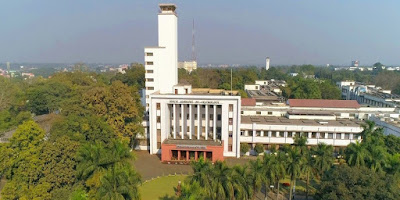West Bengal has the potential to start a second Green Revolution : Ramesh Pokhriyal Nishank
Biswabrata Goswami
Hummingbird News
KHARAGPUR, 27 JAN: West Bengal has the potential to start a second Green Revolution. Prime Minister has set a target of doubling the income of farmers by 2022-23 and The Government of India has taken several steps for the overall and sustainable development of Indian agriculture, said Union Education Minister Ramesh Pokhriyal ‘Nishank’.
He
on Monday flagged off the Agri-Food Techathon at IIT Kharagpur and also laid
the foundation for Agri-Business Incubation Centre, which will incubate
innovative ideas in agriculture and food technology domain for creating
Agri-preneures.
Drawing
reference of Prime Minister’s address at the programme of laying the foundation
stone of the Indian Agricultural Research Institute in Barhi, Dr Pokhriyal
quoted, “Prime Minister Narendra Modi has also said that West Bengal is the
focal point for bringing agricultural reform in India.”
Addressing the first Agri-Food Techathon organized by NABARD and IIT Kharagpur, Dr Pokhriyal said, “I am happy that Agri-Food Tekathon is associated with Shastri's ideal of 'Jai Jawan, Jai Kisan'. Shastri started the Green Revolution to make India self-reliant. He believed in the powers of farmers to bring a revolution in India's agricultural ecosystem. He believed in the strong relationship between farmers - food grains and life.”
This
Techathon has been organized to promote the participation of the youth of India
in innovation and entrepreneurship in various sectors of the agri-food sector.
This agri-food techthon will identify new ideas for startup incubation in the
region and help them become successful businesses. The main objective of this
event is to find new solutions to agricultural problems through technical talks
by encouraging academics and encouraging young farmers, besides spreading
awareness is also an important objective of this program.
NABARD
Chairman Dr. GR Chintala, IIT Kharagpur Director Prof. VK Tiwari, Deputy
Director Prof. SK Bhattacharya, Head of Agriculture and Food Engineering and
Center for Rural Development and Innovative Sustainable Technology, Prof Rintu
Banerjee, Rajendra Mishra of IIT Kharagpur Professor CS Kumar, Head of School
of Engineering Entrepreneurship, Professor HN Mishra, Nodal Officer,
Agriculture Business Incubation Center, IIT Kharagpur were also present.
Agri-food
startups are bringing a big change in the Indian food and agriculture sector by
removing the shortcomings of the agricultural value chain, providing efficient
products, technology and services to both farmers and consumers. They are
providing services such as ICT app, farm automation, weather forecasting
services, drones, inputs retailing, equipment hiring, online vegetable marketing,
smart poultry and dairy, protected farming and innovative food processing and
packaging. In 2018, there were around 500 agri startups in India which is very
encouraging as these startups have raised around $ 130 million investment in
the last five years.
Dr. Nishank further said, “I am happy that the measures being adopted by IIT Kharagpur have been integrated with the National Education Policy. Our new education policy is focused on interdisciplinary education and will ensure what students want to learn. Likewise, this Agri-Food Tekathon will identify new concepts and new ideas for agri-food startup incubation and will also help in transforming these start-ups into successful business ventures. Also, according to our new education policy, vocational education will start in schools from sixth grade and will include internships. Increasing the importance of vocational education will greatly benefit the growth of agri-food startups.”
The two-months long national-level online technical fest at IIT Kharagpur will have participation from over 750 university/college students, entrepreneurs and rural youths from across the country in the age range of 20-25 years with diverse academic backgrounds.
Speaking on the occasion, Dr. G.R. Chintala,
Chairman, NABARD, who was the Guest of Honor, said, “Keeping in mind the requirement of technological interventions in the agriculture sector, this techathon will create an ecosystem for the youth of our country to share the knowledge for improving the conventional farming practices for the benefit of our farmers. Agri-Food Techathon 2021 will provide a great boost to the young startups working on cost-efficient technologies for the agriculture sector.”
Highlighting the unique aspects of Agri-Food Techathon 2021 initiative, Prof. V.K. Tewari, Director, IIT Kharagpur, said, “We are moving at a fast pace to achieve the target of 125 incubatees in the next five years through Agri-Business Incubation Centre (ABIC). In order to meet the food requirements of 135 crore people, we require innovation. We need to produce more out of small land. Our Hon’ble Prime Minister Shri Narendra Modi has already said in 2015 that by 2022, the income of the farmer must be doubled.”
“We are also working on that aspect. The population involved in agriculture is shrinking due to their movement to construction, infrastructure development and other activities due to various reasons. There is a need for more and more mechanisation and innovation. Until and unless we use technology such as AI/ML, image processing, Embedded systems and IoT, it will not be possible to maximise the income of the farmer and maximise the yield out of the land. IIT Kharagpur has trained over 11,000 farmers in the last ten years on various kinds of irrigation water, drip irrigation and many other ideas from this Department,” Prof. Tewari said.









































